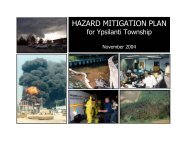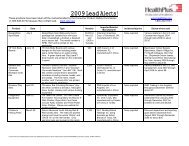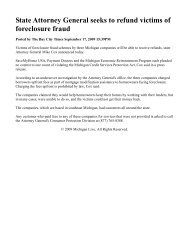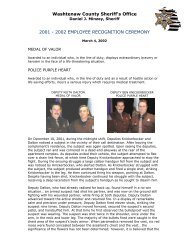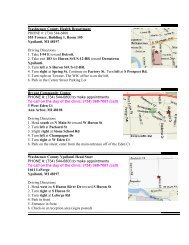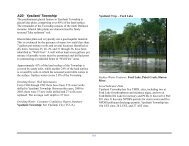Water Protection Activities in Washtenaw County
Water Protection Activities in Washtenaw County
Water Protection Activities in Washtenaw County
Create successful ePaper yourself
Turn your PDF publications into a flip-book with our unique Google optimized e-Paper software.
Challenge #10 Sediments<br />
Runoff from ra<strong>in</strong>storms and snowmelt is the most significant<br />
source of water pollution today. Sediment from construction<br />
sites, agricultural activities, and urban landscapes, is a pr<strong>in</strong>cipal<br />
constituent of polluted runoff. In addition, sediment from<br />
stream bank and channel erosion, result<strong>in</strong>g from excessive<br />
stormwater volumes and flows rush<strong>in</strong>g <strong>in</strong>to local waterways, is<br />
another major source of sediment deposition. Sediment is a<br />
physical concern; it can clog catch bas<strong>in</strong>s, culverts and stream<br />
channels, caus<strong>in</strong>g flood<strong>in</strong>g, imped<strong>in</strong>g navigation and<br />
recreational uses, and requir<strong>in</strong>g expensive dredg<strong>in</strong>g. It can<br />
smother habitat and spawn<strong>in</strong>g areas. In addition, because of the<br />
range of pollutants, <strong>in</strong>clud<strong>in</strong>g nutrients and toxic chemicals,<br />
some of which can b<strong>in</strong>d with soil, it is also a source of<br />
chemical pollution, result<strong>in</strong>g <strong>in</strong> nuisance aquatic weed growth<br />
and algal blooms.<br />
Sediment Response Objective<br />
M<strong>in</strong>imize sediment delivery to waterways from storm water<br />
runoff, and reduce stream channel erosion. Limit impact of <strong>in</strong>lake<br />
sediment through management practice.<br />
Sediment Response Results<br />
<strong>Washtenaw</strong> <strong>County</strong> and local units of local government can<br />
control construction erosion under Part 91 of Michigan Public<br />
Act 451 of 1994 (NREPA). All construction sites of 1 acre or<br />
more or with<strong>in</strong> 500 feet of an <strong>in</strong>land lake or stream must<br />
develop and implement an approved soil erosion and<br />
sedimentation control plan. Such plans are also required under<br />
the federal Clean <strong>Water</strong> Act. The law requires that a log be<br />
kept at every construction site, and that all erosion control<br />
measures be <strong>in</strong>spected and ma<strong>in</strong>ta<strong>in</strong>ed after any significant ra<strong>in</strong><br />
event.<br />
48<br />
Habitat Total Maximum Daily Loads, under Section 303(d) of<br />
the Clean <strong>Water</strong> Act, are <strong>in</strong> place for local streams <strong>in</strong>clud<strong>in</strong>g<br />
Malletts and Swift Run, mandat<strong>in</strong>g a plan of action for<br />
sediment reduction.<br />
The Rules of the<br />
<strong>Washtenaw</strong> <strong>County</strong> Dra<strong>in</strong><br />
Commissioner require that<br />
storm water be collected and<br />
managed prior to leav<strong>in</strong>g a<br />
developed site at a regulated<br />
rate, thereby reduc<strong>in</strong>g the<br />
high velocities that lead to<br />
channel erosion.<br />
What protection activities<br />
address the challenge of<br />
sediments?<br />
Clean <strong>Water</strong> Act<br />
Michigan Dra<strong>in</strong> Code<br />
<strong>Water</strong>shed Management Plans<br />
Illicit Discharge Elim<strong>in</strong>ation<br />
NREPA (Part 91, Soil Erosion<br />
and Sedimentation Control)<br />
<strong>Water</strong>shed plans <strong>in</strong> urban areas call for retrofitt<strong>in</strong>g and<br />
ma<strong>in</strong>ta<strong>in</strong><strong>in</strong>g BMPs, such as storm water ponds, to provide<br />
better flow control and sediment removal. Close to $4 million<br />
is be<strong>in</strong>g spent along Malletts Creek (Mary Beth Doyle Wetland<br />
Preserve) to advance these objectives. Riparian buffer<br />
ord<strong>in</strong>ances are also under development and/or implementation.<br />
These natural areas can filter runoff and keep sediment out of<br />
waterways.<br />
Stream bank stabilization projects have been conducted<br />
throughout the <strong>County</strong>. Johnson Creek, a tributary with<strong>in</strong> the<br />
Arboretum, and Traver Creek are some of the waterways where<br />
projects have been implemented. Others are underway on Mill<br />
and Miller Creeks.<br />
Rout<strong>in</strong>e dra<strong>in</strong> ma<strong>in</strong>tenance conducted under the Michigan<br />
Dra<strong>in</strong> Code provides for sediment removal from stream<br />
channels, culverts, and stormwater structures.



